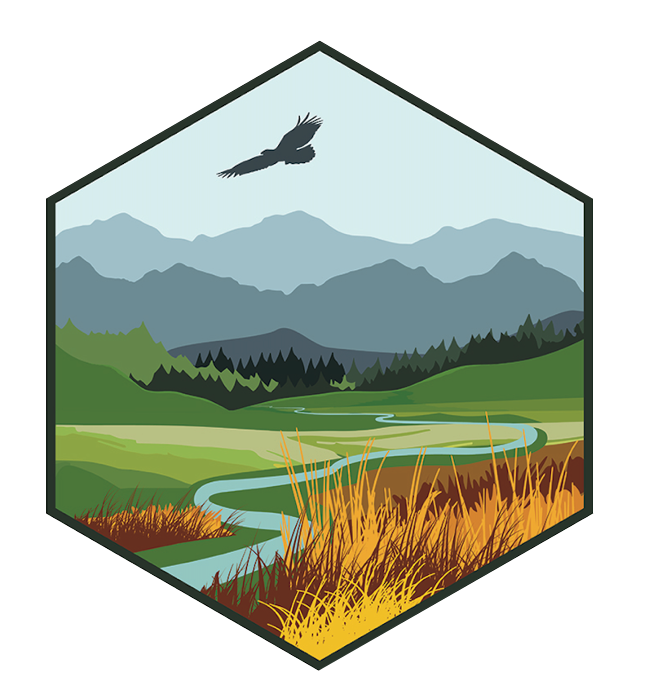Historical and projected climate data and water balance data under three GCMs (CNRM-CM5, CCSM4, and IPSL-CM5A-MR) from 1980 to 2099 was used to assess projected climate change impacts in North Central U.S. We obtained required data from MACA data (https://climate.northwestknowledge.net/MACA/). Historical time period ranges from 1980 to 2005, and projected time period ranges from 2071 to 2099. The climate data includes temperature and precipitation whereas water balance data includes Potential Evapotranspiration (PET) and Moisture Index (MI) estimated using Penman-Monteith and Thornthwaite methods defining as Penman PET, Penman MI, Thornthwaite PET and Thornthwaite MI. Both types of MI was estimated as a ratio of Precipitation and Evapotranspiration. The MACA data includes Penman PET which was estimated using Penman-Monteith methods. However, Thornthwaite PET was estimated using Thornthwaite methods for this project.
Landscapes
Pinyon pine woodlands are among the most widespread and iconic vegetation types in the western United States and support recreation, resource extraction, grazing, and cultural enrichment. However, severe drought conditions have recently caused dramatic mortality of pinyon pines, creating concern about the long-term impact of increasing aridity on the viability of pinyon woodlands. Ecological transformations, or regime shifts, are rapid reorganizations of an ecosystem’s species composition, governing processes, and functions. The goal of this project is to investigate ecological transformation across the Western U.S, characterize the environmental drivers of these changes in vegetation, and apply those insights to map contemporary transformation risk – across pinyon pine woodlands and other vegetation types in the U.S. West. Researchers will do this by employing data from existing paleorecords and statistical analysis of recent observations to understand what controls ecological transformations and assess the potential for 21st century transformation in pinyon pine woodlands. The primary product will be maps depicting the risk of existing pinyon and other systems transforming to other vegetation types. These maps will help resource managers understand the potential for important change in pinyon resources, helping them maximize the long-term effectiveness of their conservation and restoration management strategies.
The bison, which has long served as the symbol of the Department of the Interior, became the official national mammal of the United States in 2016. Bison played a key role in shaping the grasslands of the Great Plains for millennia, but today they are confined to unnaturally small ranges. National parks, including four in the Great Plains, provide a major last bastion for wild bison. Herds in Badlands National Park and Wind Cave National Park in South Dakota, Tallgrass Prairie National Preserve in Kansas, and Theodore Roosevelt National Park in North Dakota are wild in that their movements are unconstrained within their park’s designated bison range, they receive no supplemental feed, minerals, or veterinary attention, and social interactions are not constrained. To maintain natural ecosystem conditions for wild bison within these parks, park managers regularly make decisions that affect bison herds, the animal communities they interact with, and the plant communities that support them. Until now, these decisions have focused on individual parks’ bison herds. The National Park Service has set forth a new initiative that strives to increase managers’ consideration of a broader range of issues when making bison management decisions in order to achieve region-wide objectives. This initiative will culminate in the National Park Service Midwest Region Strategic Bison Management Plan. As part of this effort, the initiative’s leadership team identified the need for a tool that evaluates the feasibility of maintaining desired bison health and ecosystem conditions in parks with bison herds under a range of potential management and climate scenarios, and that assesses how short-term management decisions could impact long-term objectives. To address this need, researchers will bring together NPS managers, biologists, and decision-makers, together with USGS and university scientists, to develop specific objectives for the bison management plan and to develop a detailed implementation plan for the production of such a tool. Close manager-scientist collaboration from the onset of the project will ensure a shared understanding of the tool’s function and capabilities. This project will serve as a first step towards the development of innovative future management of bison in national parks.
Fossil fuel and agriculture have increased atmospheric concentrations of the greenhouse gases carbon dioxide and methane, which have caused global air temperature to increase by almost 1- degree Celsius. In the absence of climate mitigation, over the next century human-driven climate change is expected to increase temperatures from pre-industrial levels by more than 2-degrees. Understanding the consequences of climate change on ecosystems and the services they provide are critical for guiding land management activities that aim to improve resiliency and to prevent species losses. Here we evaluated how sagebrush ecosystems in the Western United States respond to climate change by using multiple climate projections and ecosystem modeling approaches to assess uncertainty and to identify future areas of field and experimental research. We find that in the absence of changes in fire, invasive species, and habitat loss, that sagebrush is tolerant of both low moisture levels and high air temperatures, and that climate change will impact the southern extent of its range most significantly. Process-based models, which consider the effects of carbon dioxide on leaf photosynthesis and water exchange show potential increases in the growth of sagebrush into the 21st century. Compared to field observations, there is a need to further constrain how sagebrush allocates carbon to roots, stems and foliage, and how these processes respond to water limitation. Agreement between modeling approaches that sagebrush is tolerant to higher air temperatures suggests that land managers should consider enhancing resilience of these systems through fire and invasive species management strategies.
America’s remaining grassland in the Prairie Pothole Region (PPR) is at risk of being lost to crop production. When crop prices are high, like the historically high corn prices that the U.S. experienced between 2008 and 2014, the risk of grassland conversion is even higher. Changing climate will add uncertainties to any efforts toward conservation of grassland in the PPR. Grassland conversion to cropland in the region would imperil nesting waterfowl among other species and further impair water quality in the Mississippi watershed. In this project, we sought to contribute to the understanding of land conversion in the PPR with the aim to better target the use of public and private funds allocated toward incentivizing grassland preservation on private lands in the Dakotas. We assembled data on historical land switching in the area and on land conversion costs. We analyzed crop vulnerabilities to weather and climate change. We examined practical analytical tools to assess the likelihood of grassland conversion to cropping. With our weather-yield-land use modeling framework we evaluated the likely outcomes of land use changes in the region. Among other land use patterns, our research indicated a possible increase of grassland acres as grasses could be less adversely impacted by changing climate. Working with farmers and conservation partners, our project assessed drivers of land use changes. In particular, while economics and climate factors were admittedly obvious important motivations for land use changes, our findings suggested that landowners’ decisions were significantly affected by non-pecuniary factors, like lifestyle choices, or some behavioral biases (e.g., recency bias, and anticipated regret factor) whose roles in economic decision making have been increasingly recognized. As landowners and conservation managers gradually adapt to changing climates, it is not only important that we understand the impacts of the changing climates, but also imperative that we are aware how landowners perceive how climate is changing and how well they are willing to embrace sound adaptation strategies.
In the previous first phase of the Impacts and Vulnerability project, we made substantial progress in assessing climate and land use change impacts across the NCCASC domain. These include: quantifying the rates of land use change in greater wildland ecosystems (GWEs), determining the extent of fragmentation in major ecosystems across GWEs, assessing climate change impacts on public, private, and tribal lands within GWEs, evaluating evaporative demands across hydroclimatic gradients of eight ecoregions across north central U.S., and predicting forest ecosystem responses to climate change. We found that rates of climate and land use change varied across the Great Plains and Rocky Mountains, as did the responses of ecosystems to these changes. We also identified the major locations highly impacted by these changes that call for crafting locally relevant adaptation strategies to cope with these changes. This second phase of the project (FY’17) aimed to generate coproduction of knowledge with a wide range of stakeholders to support decision making for the management and conservation of affected areas. During this FY’17 phase of the project, we worked with various user groups to evaluate potential land use and climate impacts and adaptation strategies for the most affected areas and ecosystem types identified by our previous work. Specifically, we focused on forest and shrubland vegetation and habitat of a selected wildlife species (Gulo gulo) in the Rocky Mountains and Washington Cascade regions. We also designed and produced resource briefs on land use and climate change assessments of selected areas and ecosystem types to provide information to coordinated management. Thirdly, we conducted series of webinars and workshops with federal, private, and NGO stakeholders to draw on all of the science results (e.g., from species distribution models, state and transition models, and mechanistic models) to identify and evaluate vegetation climate adaptation strategies for the Custer Gallatin National Forest Plan Revision that are robust under climate uncertainty.
Land use change ranges in each panel are in acres per thousand county acres. The white colored counties represent missing yields for at least one crop in all years.
2006 Land Use in the Dakotas (Cropland Data Layer, USDA NASS). The color legend represents various land use types in the region.

